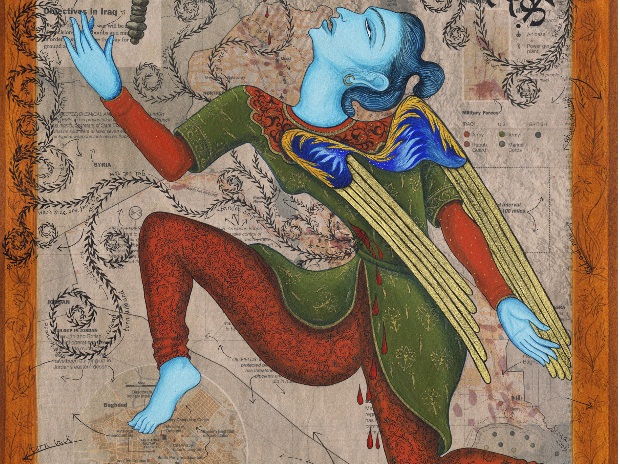JEWS AND THE INDIAN NATIONAL ART PROJECT
Author: Kenneth X Robbins, Marvin Tokayer (eds)
Publisher: Niyogi Books
Pages: 376
Price: Rs 3,500
From 1933 to 1945, the Nazis orchestrated the most massive art theft in history. Many of the works looted from Jewish art collectors are in major museums today, demanding unsettling questions to be answered. Less is known that, during this same period, many European Jews, including several fleeing Hitler and Fascist Europe, played a critical role in developing Indian art in the early 20th century. Jews and The Indian National Art Project reveals the role that Jews played in the development of the Indian National Art Project, which sought to connect India to its past and drew upon its rich Indian traditions and art heritage.
Kenneth X Robbins and Marvin Tokayer make an important point — that the endeavour to innovate and create an “Indian” contemporary art was never a “hermetically sealed quest for purity”. Although the movement engaged Indian artists, scholars, critics and patrons, this endeavour was always outward-looking. Key players in this movement were: Maharaji Sayaji Rao III Gaekwad of Baroda, the Tagores and the Bengal School of Art, and the J J School of Art and the Progressive Artists’ Group of Bombay, as it was then called.
This unique book, with its visual treat of luminous works of art and images, captures the pivotal roles many European Jews played in this cultural flowering.

Atiya Begum
The book highlights the personal contributions of Western Jews in India, and provides insights into the passions and the intellectual questions they debated along with their Indian counterparts. Among the Jewish stars in this firmament was Stella Kramrisch, an American Jewish art historian deeply connected to the Bengal School. She was largely responsible for reconfiguring Indian art and artists in Europe. Her pioneering exhibition in Calcutta in 1922 had Indian artists displayed among 175 works of European artists, including Paul Klee and Wassily Kandinsky.
Gladstone Solomon, principal of J J School of Arts (1918-1936), was also influential in defining Indian art. Marionn Harry Spielman, a curator for Maharaja of Baroda’s pioneering and comprehensive art collections, bought over 190 European paintings for Sayaji Rao. Sir William Rothenstein, Kramrisch and Solomon helped to shape debates about the appropriate training of artists and aesthetic values, evaluation of Indian paintings, and the purpose of Indian art education and nationalist art theory. Although Robbins does acknowledge the critics who questioned Europeans having a defining role in the Indian National Art Project, he does not delve deeper into the topic to make a compelling counter-narrative.

The last seven essays in the book move beyond the Indian National Art Project to feature European and Indian Jews engaged with the arts in India: artists, photographers, dancers, architects and art patrons till present day, making the book title something of a misnomer. These include the Bagdadi Jewish Calcutta photographer David Mordechai, who played an important role in the development of Indian photography, documenting the last days of the British Raj and early post-Independence era. With over 100 studio employees, Mordechai’s travels and observational photography “documented the concept of an India that could be known,classified, represented and controlled”.

Painting titled "Brother and Sister" by Magda Nachman
Carmel Berkson, an American Jewish artist scholar, was awarded the Padma Shri (2010). Her books and photographs dealing with Hindu sculpture are considered classics. Anish Kapur, also a Padma Shri awardee (2012), whose mother was a Bagdadi Jew, was raised in India and spent his teenage years in Israel. The art of Rebecca Yehezekiel and Siona Benjamin, Bene Israeli artists, draws inspiration from their Indian heritage while living transnational lives. Benjamin’s art incorporates elements of Mughal, Rajput and contemporary schools of miniature painting and the volume has many wonderful images of her incandescent art works.
The last chapters of the book inexplicably look beyond the Indian National Art Project, referencing Jewish artists such as Martha Isaacs, Mirra Alfassa (the Mother) and Anna Molka Ahmed; architects such as Joshua Benjamin, Louis Kahn and Moshe Safdie; and patrons of the art such as Jean Baptiste Ventura who have been treated more fully in Robbins and Tokayer’s Western Jews in India.

The Rothensteins and Tagores
It is intriguing to note that aside from Yehezekiel and Benjamin, who drew inspiration from their Jewish cultural roots, none of the others represented drew on their Jewish heritage, and many did not even acknowledge their Jewish identity. The book raises but does not seek to answer interesting questions regarding why Western Jews were drawn to the effort to connect India to its pre-colonial traditions.
The reviewer is a Nehru Fulbright scholar


)
